Design & Build a Seed Sorter

Assortment of seeds (cynoclub, iStockphoto)

Assortment of seeds (cynoclub, iStockphoto)
How does this align with my curriculum?
| Grade | Course | Topic |
|---|
Students will work collaboratively to design and build a device that is able to sort seeds by size.
Overview
In this Design & Build challenge, students will work collaboratively towards a common goal of constructing a sorting device that will assist students to sort seeds by size.
Timing
45-60 minutes
Setting the Stage
Prior Skills and Knowledge
To successfully participate in this Design & Build, students should be able to use basic cutting tools and fasteners and have a basic understanding of how to sort by size.
Context
Seeds are an important part of the natural world and the business of agriculture in Canada. Many kinds of seeds become food for animals and humans. Some seeds are used to produce more crops and grow more food in following years. Canadian farmers also sell their crops as seed to other farmers all around the world to produce food and animal feed.
Before crops are sold, they are graded based on the quality of the seeds and the amount of weed seeds in the crop. (It’s a bit like getting a mark at school!) A crop with fewer weed seeds and larger, more uniform seeds gets a better grade because bigger seeds usually produce stronger new plants. Seeds can be used for different purposes (seed stock, human food, processed foods and animal feed, etc). Crop sellers must make sure they have the best seeds for the purpose they want to sell them for. That's why it's important to sort seeds.
In this Design & Build challenge, students will work collaboratively towards a common goal of constructing a sorting device that will assist students in sorting seeds by size.
This design and build could begin from:
- exploring photos of crops being harvested. Discuss using questions such as:
- “Why does a grain company need to sort seeds? How do they do this?”
- “In a huge field there might be some weeds that grow as well as the crop. How do you think grain companies remove weed seeds from the crop seeds?”
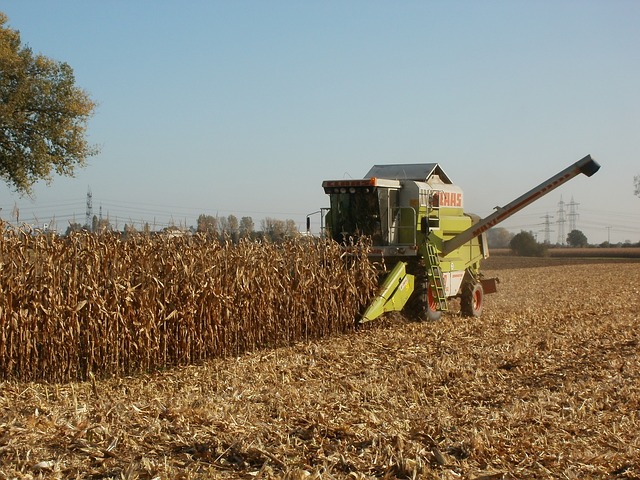
- exploring real ears of corn, heads of wheat or barley or soybean pods. Discuss using questions such as:
- “Do all the seeds on this corn cob/wheat head/soybean pod look the same? Are all seeds of a crop the exact same size?”
- “Would you want to eat all of these kernels/seeds?”
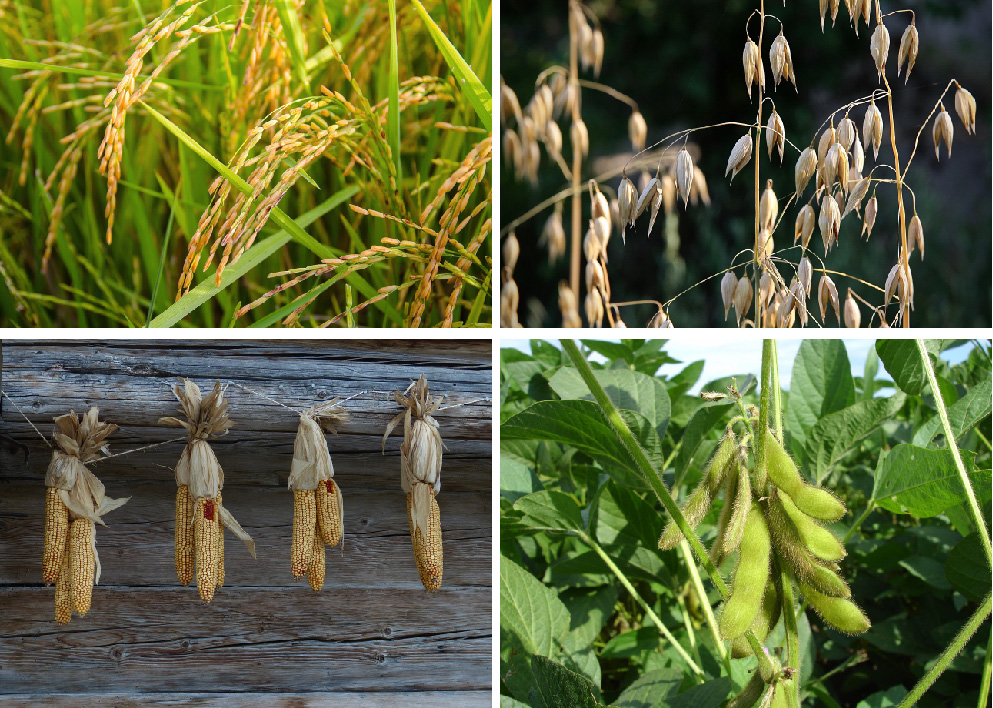
- Reading a book such as The Empty Pot by Demi. Discuss using questions such as:
- “How does the emperor choose which person will replace him as emperor?”
- “What do you think are the qualities of a good emperor?”
- “What was the problem with the seeds the emperor gave to the children to plant? What was the emperor really trying to prove?”
- “Was the emperor successful at finding the best kind of new emperor?”
- “We sometimes hear the expression – ‘he/she is a good seed’ or ‘he/she is a bad seed’. What do you think that means?”
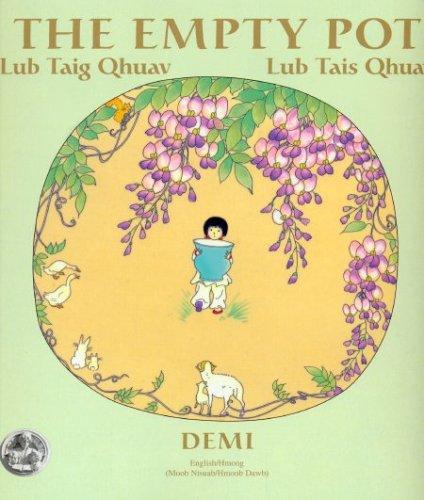
Design Criteria
As a class, students brainstorm criteria that their prototype seed sorter must meet. Educators may choose to add other criteria that are curriculum-specific. For example, educators may instruct students to use joiners/fasteners, specific measurements, specific materials, etc.
Design criteria examples:
- The seed sorter will sort seeds into three different sizes
- The seed sorter must use at least one type of fastener
- The seed sorter cannot require outside force (e.g., shaking it) to work
Details
- Seeds of three distinct sizes for sorting (e.g., large: lima beans/kidney beans; medium: soybeans/popcorn; small: tomato seeds/millet/rice/barley) – alternately, use commercial bird seed
- Funnels of different sizes
- Paper or Styrofoam cups, varied sizes
- plastic flat-bottomed containers or trays to catch and contain seeds
- construction paper and/or cardstock
- paper punches or craft punches of different sizes
- other materials such as craft sticks, drinking straws, string
- tools and fasteners such as tape, glue, other fasteners
- scissors
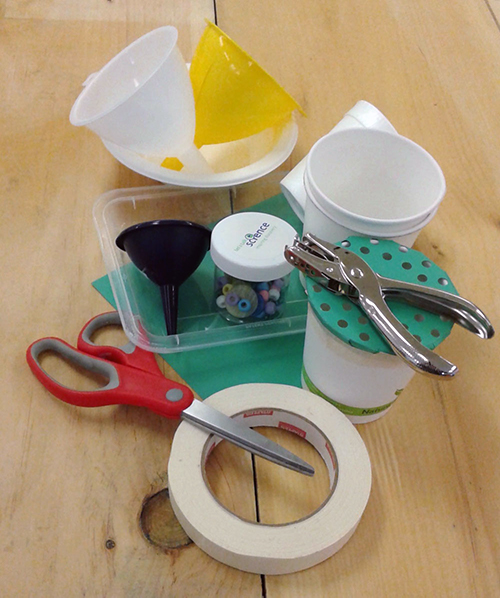
- Collect an assortment of recycled and new materials that students will use to construct the prototype seed sorter. The materials list above is only a suggested list.
- Set up material sourcing stations, organized by type of material. Alternatively, organize an assortment of materials to be provided.
- Source and combine seeds for sorting.
- If there are students with allergies or concerns about using food seeds for this challenge, consider substituting beads of 3 different sizes. Check that the smallest beads will be able to go through one of the available funnels.
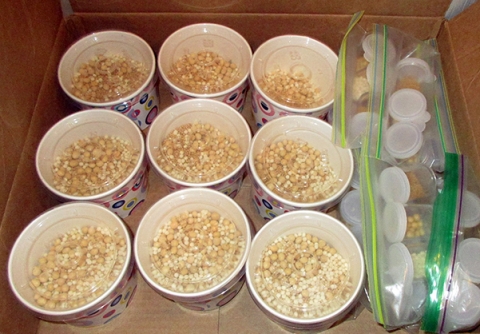
Students develop Design & Build skills as they design, build and test a seed sorter that will separate seeds into at least three different sizes.
Students will follow the steps of the Design & Build process:
- identify the problem to be solved/need to be met
- brainstorm criteria that the prototype must meet
- share their questions and ideas for a solution to the problem/need
- discuss the pros and cons of each in order to select a potential solution to test
- visualize what the solution might look like and make design sketches based on their visualizations
- identify the tasks or key steps involved in developing the solution (the design plan)
- make decisions about tools and materials that will be needed
- build/develop the design idea based on their sketches and design plan
- test their prototypes based on the design criteria
- modify the prototype and retest it against the design criteria as necessary
- reflect on their results and identify things that could be done to improve their prototypes
Observe and document, using anecdotal comments, photos and/or video recordings, student’s ability to:
- Work Collaboratively – students work collaboratively to complete a task and evaluate their group processes throughout the Design & Build process
- Generate Ideas – students use idea generation skills and strategies, such as brainstorming, to identify possible solutions as well as make decisions about the pros and cons of each solution
- Communicate – students communicate their thinking and learning in words, sketches, photos, videos, etc. (e.g., in identifying the problem, in design plans that include 2D design sketches and key design steps/tasks, in lists of materials/equipment/tools)
- Work Safely – students demonstrate safe practices when using a variety of tools and materials while prototyping
- Test – students use skills of observing and recording data as they test their prototypes
- Reflect – students reflect on the results of their prototype testing and suggest things that they might do differently to improve their prototypes
| Students: Saying, Doing, Representing |
Educator: Interactions: Responding, Challenging |
|---|---|
| Students identify and refine the problem to be solved/need to be met. |
|
| Students brainstorm and record criteria for the seed sorter. |
|
| Students visualize what the solution might look like and make design sketches based on their visualizations. |
|
| Students make observations and decisions about the available tools and materials. |
|
| Students build/develop and test the design idea based on their sketches and design plan (create the “prototype”). |
|
| Students modify the prototype and retest it against the design criteria as necessary. |
|
| Students reflect on the results of their testing and identify things that could be done differently in the future. |
|
Literacy
- Ask questions (e.g. “Why do we need to sort seeds? How can technology help us do these tasks?”)
- Communicate thoughts, feelings and ideas. For example:
- brainstorm unique ways to use materials to sort the seeds
- propose improvements to the initial seed sorter design
- present results of the Design & Build process
- discuss other seed-related technologies that are involved in farming and agriculture
- Use a variety of forms (e.g., oral, written, graphic, multimedia) to communicate with different audiences and for a variety of purposes (e.g., to make a prototype model of a seed sorter)
Mathematical Thinking
- Measure the diameter of the seeds (in millimetres) in preparation for designing and building the seed sorter
- Using spatial reasoning and sequencing when designing and constructing the seed sorter
Visual Arts
- Sketching, representing and modeling the seed sorter prototype
Computational Thinking: Abstraction
- Use spatial reasoning and sequencing when designing and constructing the seed sorter (e.g., draw a concept design of a seed sorter)
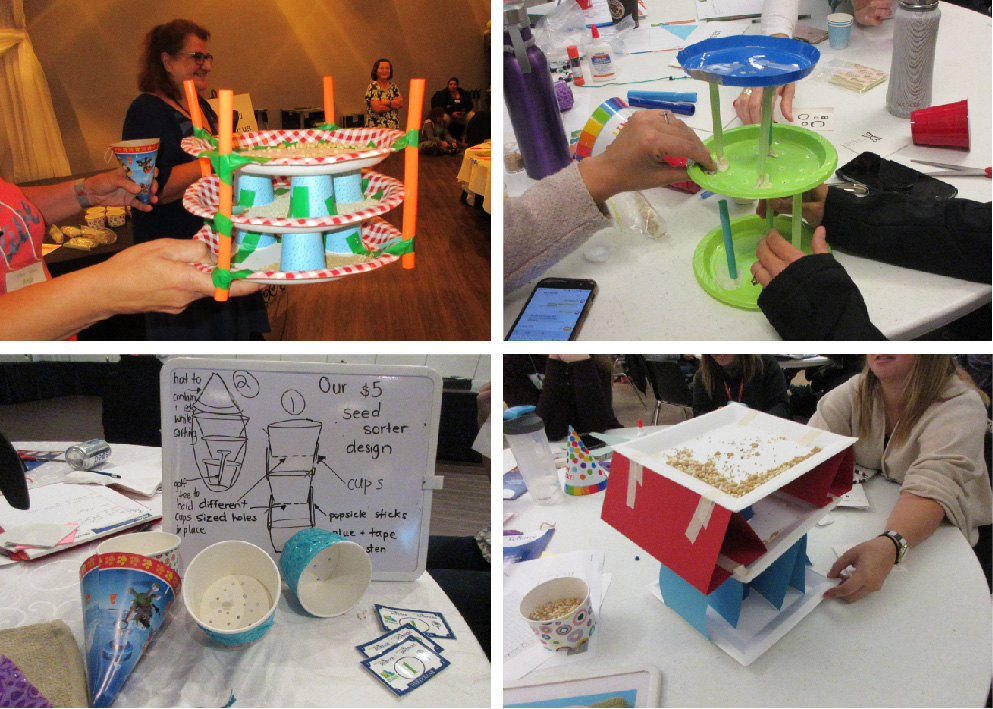
If your students are interested in learning more, the following may provoke their curiosity:
- Conduct another inquiry to compare the germination process in different plant species from the seeds that have been sorted in this Design & Build. Is there any connection between the rate of germination and the size of seeds? (For example, do small seeds germinate faster than large seeds?)
- Indigenous cultures have legends and traditional agricultural customs that involve growing crops together, as opposed to monoculture (single-species crops). The Three Sisters Legend is based on the practice of growing corn, beans and squash together. The corn supports the growing beans and the leaves of the squash cover the ground around the base of the plants to stop weeds from growing. Have students watch a video of The Three Sisters Legend without telling them which plants each of the girls represents.
- Participate in Tomatosphere™, operated by Let’s Talk Science, and learn whether tomato seeds germinate differently if they have been to space.
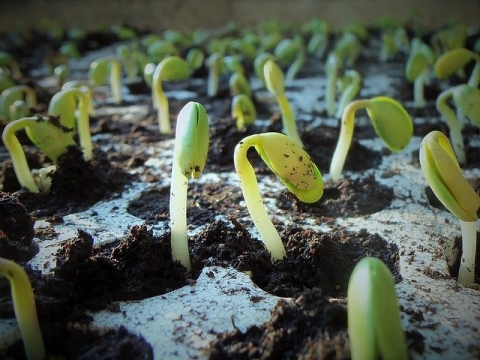
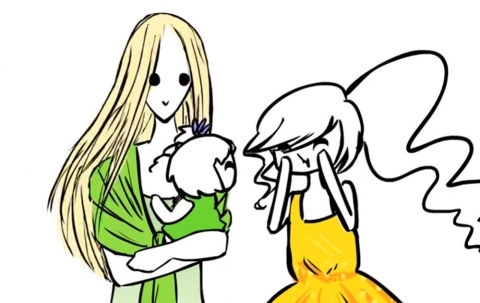
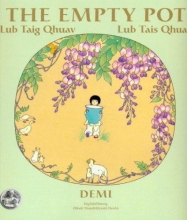
The Empty Pot
By Demi
When Ping admits that he is the only child in China unable to grow a flower from the seeds distributed by the Emperor, he is rewarded for his honesty.
ISBN 0962929859
The Three Sisters Legend (2015) Widdifield Courtyard -- Animated video (3:06 min.) of the Iroquois legend of The Three Sisters garden.
Design & Build a Seed Saver (Lessons)
Students will work collaboratively to design and build a structure that will protect a seed from the elements.
Seed Dispersal (Lessons)
Students develop and apply the skills of observing, comparing, contrasting, sorting and classifying, to investigate how seeds move from place to place.
Design & Build a Travelling Seed (Lessons)
Students will work collaboratively to design and build models of seeds that can travel as far as possible.
Tomatosphere™ (Website)
How does outer space affect plants and seeds? Join Tomatosphere™, a free program where Kindergarten to Grade 12 students use "space" tomato seeds to learn about plants in space, right here on Earth. Tomatosphere™ engages students in real scientific processes that teach and reinforce inquiry skills while they explore concepts related to plants, space, careers, nutrition and agriculture.
Materials
- Seeds of three distinct sizes for sorting (e.g., large: lima beans/kidney beans; medium: soybeans/popcorn; small: tomato seeds/millet/rice/barley) – alternately, use commercial bird seed
- Funnels of different sizes
- Paper or Styrofoam cups, varied sizes
- plastic flat-bottomed containers or trays to catch and contain seeds
- construction paper and/or cardstock
- paper punches or craft punches of different sizes
- other materials such as craft sticks, drinking straws, string
- tools and fasteners such as tape, glue, other fasteners
- scissors

Preparation
- Collect an assortment of recycled and new materials that students will use to construct the prototype seed sorter. The materials list above is only a suggested list.
- Set up material sourcing stations, organized by type of material. Alternatively, organize an assortment of materials to be provided.
- Source and combine seeds for sorting.
- If there are students with allergies or concerns about using food seeds for this challenge, consider substituting beads of 3 different sizes. Check that the smallest beads will be able to go through one of the available funnels.

What to Do
Students develop Design & Build skills as they design, build and test a seed sorter that will separate seeds into at least three different sizes.
Students will follow the steps of the Design & Build process:
- identify the problem to be solved/need to be met
- brainstorm criteria that the prototype must meet
- share their questions and ideas for a solution to the problem/need
- discuss the pros and cons of each in order to select a potential solution to test
- visualize what the solution might look like and make design sketches based on their visualizations
- identify the tasks or key steps involved in developing the solution (the design plan)
- make decisions about tools and materials that will be needed
- build/develop the design idea based on their sketches and design plan
- test their prototypes based on the design criteria
- modify the prototype and retest it against the design criteria as necessary
- reflect on their results and identify things that could be done to improve their prototypes
Assessment
Observe and document, using anecdotal comments, photos and/or video recordings, student’s ability to:
- Work Collaboratively – students work collaboratively to complete a task and evaluate their group processes throughout the Design & Build process
- Generate Ideas – students use idea generation skills and strategies, such as brainstorming, to identify possible solutions as well as make decisions about the pros and cons of each solution
- Communicate – students communicate their thinking and learning in words, sketches, photos, videos, etc. (e.g., in identifying the problem, in design plans that include 2D design sketches and key design steps/tasks, in lists of materials/equipment/tools)
- Work Safely – students demonstrate safe practices when using a variety of tools and materials while prototyping
- Test – students use skills of observing and recording data as they test their prototypes
- Reflect – students reflect on the results of their prototype testing and suggest things that they might do differently to improve their prototypes
Co-constructed Learning
| Students: Saying, Doing, Representing |
Educator: Interactions: Responding, Challenging |
|---|---|
| Students identify and refine the problem to be solved/need to be met. |
|
| Students brainstorm and record criteria for the seed sorter. |
|
| Students visualize what the solution might look like and make design sketches based on their visualizations. |
|
| Students make observations and decisions about the available tools and materials. |
|
| Students build/develop and test the design idea based on their sketches and design plan (create the “prototype”). |
|
| Students modify the prototype and retest it against the design criteria as necessary. |
|
| Students reflect on the results of their testing and identify things that could be done differently in the future. |
|
Cross-curricular Connections
Literacy
- Ask questions (e.g. “Why do we need to sort seeds? How can technology help us do these tasks?”)
- Communicate thoughts, feelings and ideas. For example:
- brainstorm unique ways to use materials to sort the seeds
- propose improvements to the initial seed sorter design
- present results of the Design & Build process
- discuss other seed-related technologies that are involved in farming and agriculture
- Use a variety of forms (e.g., oral, written, graphic, multimedia) to communicate with different audiences and for a variety of purposes (e.g., to make a prototype model of a seed sorter)
Mathematical Thinking
- Measure the diameter of the seeds (in millimetres) in preparation for designing and building the seed sorter
- Using spatial reasoning and sequencing when designing and constructing the seed sorter
Visual Arts
- Sketching, representing and modeling the seed sorter prototype
Computational Thinking: Abstraction
- Use spatial reasoning and sequencing when designing and constructing the seed sorter (e.g., draw a concept design of a seed sorter)

Extending the Learning
If your students are interested in learning more, the following may provoke their curiosity:
- Conduct another inquiry to compare the germination process in different plant species from the seeds that have been sorted in this Design & Build. Is there any connection between the rate of germination and the size of seeds? (For example, do small seeds germinate faster than large seeds?)
- Indigenous cultures have legends and traditional agricultural customs that involve growing crops together, as opposed to monoculture (single-species crops). The Three Sisters Legend is based on the practice of growing corn, beans and squash together. The corn supports the growing beans and the leaves of the squash cover the ground around the base of the plants to stop weeds from growing. Have students watch a video of The Three Sisters Legend without telling them which plants each of the girls represents.
- Participate in Tomatosphere™, operated by Let’s Talk Science, and learn whether tomato seeds germinate differently if they have been to space.


Supporting Media

The Empty Pot
By Demi
When Ping admits that he is the only child in China unable to grow a flower from the seeds distributed by the Emperor, he is rewarded for his honesty.
ISBN 0962929859
The Three Sisters Legend (2015) Widdifield Courtyard -- Animated video (3:06 min.) of the Iroquois legend of The Three Sisters garden.
Learn More
Design & Build a Seed Saver (Lessons)
Students will work collaboratively to design and build a structure that will protect a seed from the elements.
Seed Dispersal (Lessons)
Students develop and apply the skills of observing, comparing, contrasting, sorting and classifying, to investigate how seeds move from place to place.
Design & Build a Travelling Seed (Lessons)
Students will work collaboratively to design and build models of seeds that can travel as far as possible.
Tomatosphere™ (Website)
How does outer space affect plants and seeds? Join Tomatosphere™, a free program where Kindergarten to Grade 12 students use "space" tomato seeds to learn about plants in space, right here on Earth. Tomatosphere™ engages students in real scientific processes that teach and reinforce inquiry skills while they explore concepts related to plants, space, careers, nutrition and agriculture.